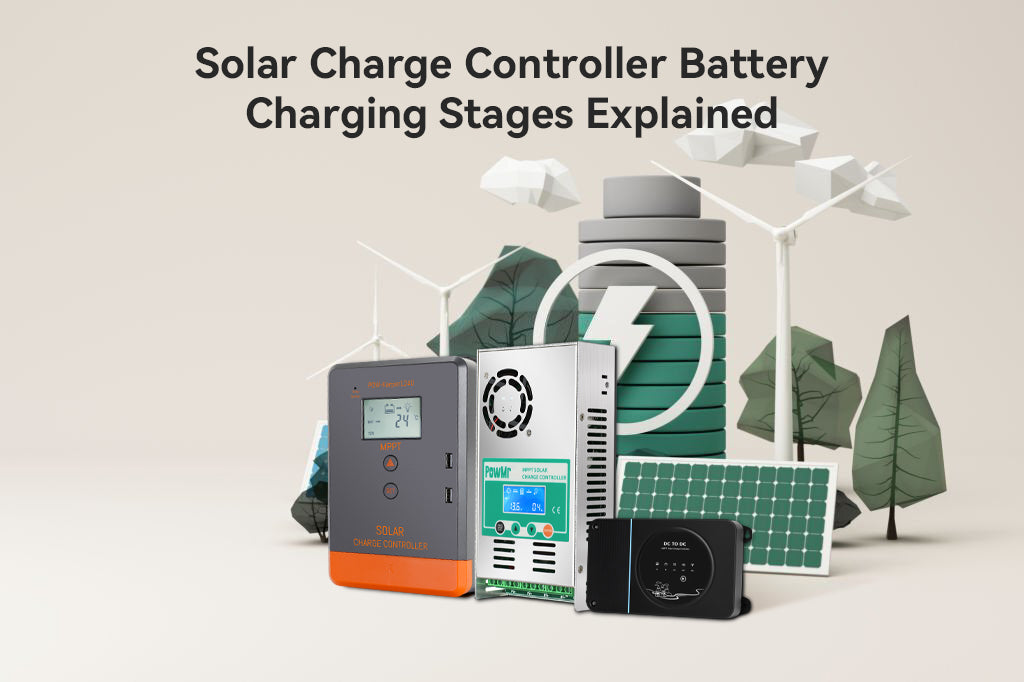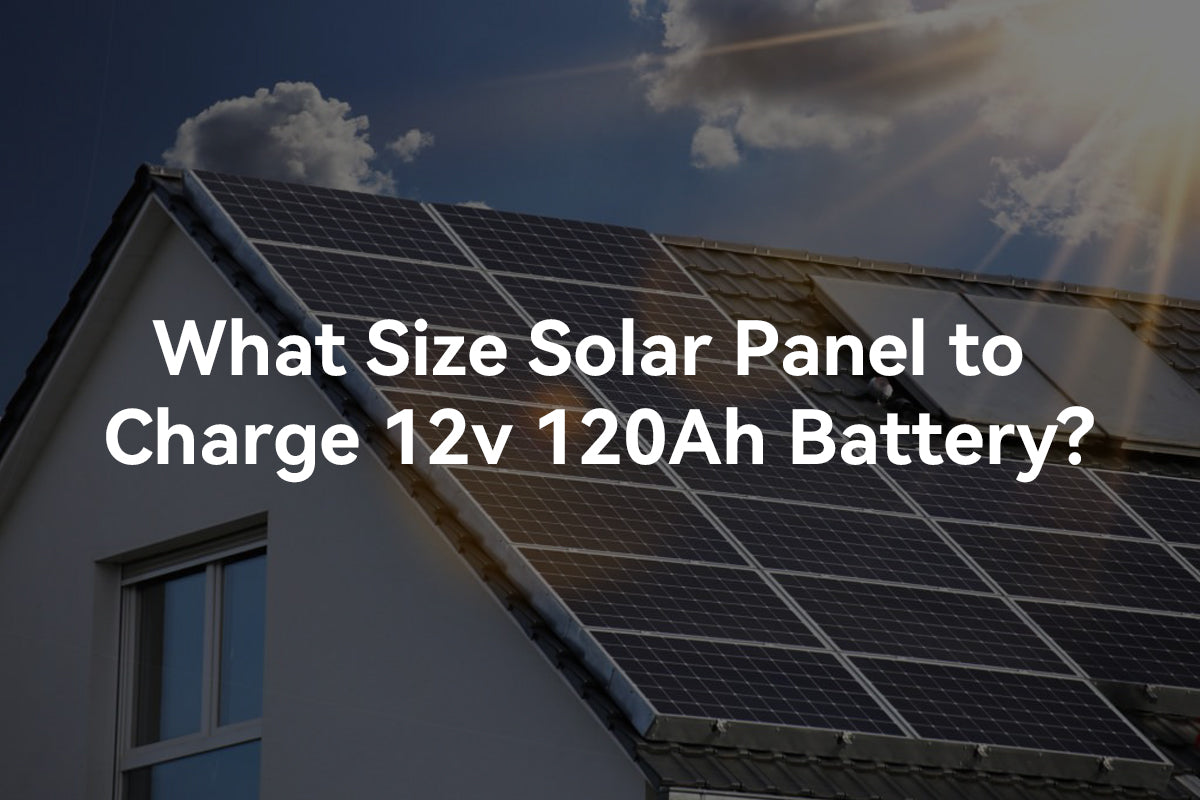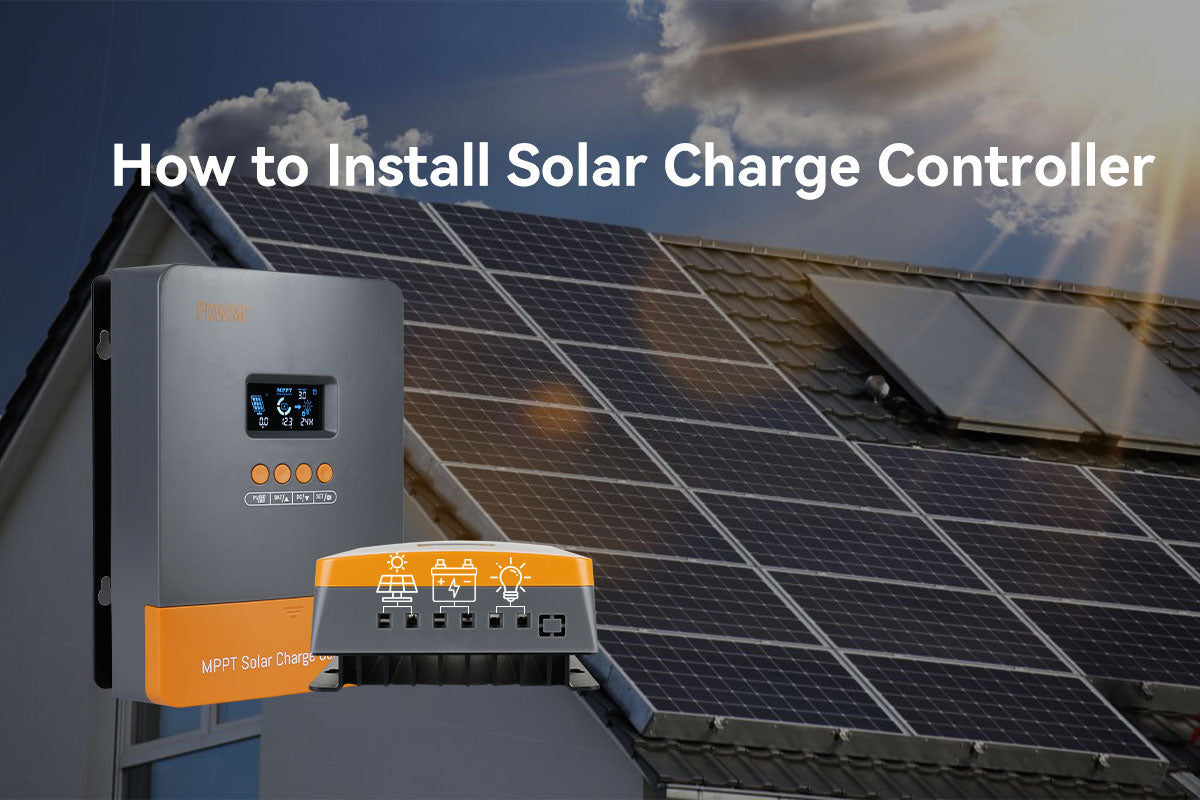เพื่อให้ใช้พลังงานแสงอาทิตย์ได้อย่างมีประสิทธิภาพ จำเป็นต้องมี ระบบชาร์จแบตเตอรี่ที่มีประสิทธิภาพ อยู่ในสถานที่ นี่คือจุดที่ ตัวควบคุมการชาร์จพลังงานแสงอาทิตย์ เข้ามามีบทบาท ทำหน้าที่เป็นผู้พิทักษ์กระบวนการชาร์จ ตัวควบคุมเหล่านี้มีบทบาทสำคัญในการ ควบคุมและจัดการการไหลของกระแส จากแผงโซลาร์เซลล์ไปยังแบตเตอรี่.
การชาร์จแบตเตอรี่โซลาร์เป็นกระบวนการที่สำคัญในการใช้พลังงานจากดวงอาทิตย์เพื่อพลังงานทดแทน การเข้าใจขั้นตอนที่เกี่ยวข้องในกระบวนการนี้เป็นสิ่งจำเป็นสำหรับการเพิ่มประสิทธิภาพและอายุการใช้งานของแบตเตอรี่โซลาร์ของคุณ.
ในบทความนี้ เราจะสำรวจ ความสำคัญ ของตัวควบคุมการชาร์จในกระบวนการชาร์จแบตเตอรี่โซลาร์เซลล์ และวิธีที่พวกเขาจัดการกับ ขั้นตอนการชาร์จที่แตกต่างกัน.
ทำไมคุณถึงต้องการตัวควบคุมการชาร์จพลังงานแสงอาทิตย์
ตัวควบคุมการชาร์จพลังงานแสงอาทิตย์ทำหน้าที่เป็นผู้พิทักษ์กระบวนการชาร์จ, ควบคุมแรงดันไฟฟ้าและกระแส จากแผงโซลาร์เซลล์เพื่อ ป้องกันการชาร์จเกิน ของแบตเตอรี่ ซึ่งอาจทำให้เกิดความเสียหายหรืออายุการใช้งานที่ลดลง.
นอกจากนี้ มัน ปกป้องแบตเตอรี่จากการปล่อยประจุมากเกินไป ซึ่งอาจทำให้เกิดความเสียหายที่ไม่สามารถกลับคืนได้ ตัวควบคุมการชาร์จจะทำให้ การดึงพลังงานสูงสุด จากแผงโซลาร์เซลล์และรักษาแบตเตอรี่ให้อยู่ในสภาพการชาร์จที่เหมาะสม ซึ่งช่วยปรับปรุง ประสิทธิภาพโดยรวมของระบบ.
นอกจากนี้, ตัวควบคุมการชาร์จพลังงานแสงอาทิตย์ ตรวจสอบและจัดการกับขั้นตอนต่าง ๆ ของการชาร์จแบตเตอรี่ เพื่อให้แบตเตอรี่ยังคงอยู่ในสภาพที่ดีและยืดอายุการใช้งานของพวกมัน.
ตัวควบคุมการชาร์จพลังงานแสงอาทิตย์จัดการกับขั้นตอนการชาร์จที่แตกต่างกันอย่างไร?
ตัวควบคุมการชาร์จพลังงานแสงอาทิตย์ใช้ อัลกอริธึมและวงจรขั้นสูง เพื่อจัดการกับขั้นตอนการชาร์จที่หลากหลายอย่างมีประสิทธิภาพ.
โพสต์ที่เกี่ยวข้อง:
MPPT กับ PMW: การเปรียบเทียบตัวควบคุมการชาร์จและคู่มือการซื้อ
"ตัวควบคุมพลังงานแสงอาทิตย์ยังให้การป้องกันต่อ แรงดันไฟฟ้าที่สูงเกินไป, การไหลของกระแสย้อนกลับ, และการเกิดก๊าซจากแบตเตอรี่มากเกินไป เพื่อให้การชาร์จมีความปลอดภัยและเชื่อถือได้."
พวกเขาปรับกระแสไฟฟ้าและแรงดันไฟฟ้าตามสถานะการชาร์จของแบตเตอรี่ เพื่อป้องกัน การชาร์จเกินหรือการชาร์จไม่พอ.
การชาร์จแบตเตอรี่โดยทั่วไปเกี่ยวข้องกับหลายขั้นตอนเพื่อให้การชาร์จมีประสิทธิภาพและปลอดภัย ขั้นตอนการชาร์จที่มักจะถูกกล่าวถึงคือ การชาร์จ 4 ขั้นตอน และ วิธีการชาร์จ 3 ขั้นตอน.
การชาร์จแบตเตอรี่มี 3 ขั้นตอนคืออะไร
แบตเตอรี่โซลาร์ส่วนใหญ่มีตัวควบคุมการชาร์จที่มีสามขั้นตอนการชาร์จ: การชาร์จแบบเต็ม, การชาร์จแบบดูดซับ, และการชาร์จแบบลอย นี่คือภาพรวมสั้น ๆ ของแต่ละขั้นตอน:

ขั้นตอนการชาร์จไฟจำนวนมาก
ในระยะการชาร์จแบบกลุ่ม ตัวควบคุมการชาร์จพลังงานแสงอาทิตย์ ส่งมอบกระแสไฟฟ้าที่อนุญาตสูงสุด ไปยังแบตเตอรี่ ระยะนี้มีเป้าหมายเพื่อทำให้สถานะการชาร์จของแบตเตอรี่สูงถึงประมาณ 80% ถึง 90%.
สำหรับ แบตเตอรี่ตะกั่ว-กรด แรงดันไฟฟ้าจะเพิ่มขึ้นเป็นประมาณ 14.5 โวลต์ สำหรับแบตเตอรี่ nominal 12v ขั้นตอนการชาร์จเริ่มต้นนี้จะเติมพลังงานให้กับแบตเตอรี่ได้อย่างรวดเร็ว เตรียมพร้อมสำหรับการชาร์จเพิ่มเติม.
ขั้นตอนการชาร์จแบบดูดซับ
หลังจากขั้นตอนการชาร์จแบบปริมาณมาก แบตเตอรี่จะเข้าสู่ระยะการชาร์จแบบดูดซับ ในระยะนี้ ตัวควบคุมการชาร์จจะใช้ การควบคุมแรงดันไฟฟ้าคงที่ ขณะที่ค่อยๆ ลดกระแสการชาร์จ.
การชาร์จที่ควบคุมนี้ ป้องกันการเกิดก๊าซจากแบตเตอรี่และความร้อนสูงเกินไป โดยทั่วไป การชาร์จแบบดูดซับจะทำให้แบตเตอรี่มีระดับการชาร์จ 98% หรือสูงกว่า เพื่อให้แน่ใจว่ามีความจุสูงสุดและอายุการใช้งานที่ยาวนาน.
ขั้นตอนการชาร์จลอย
เมื่อแบตเตอรี่มีสถานะการชาร์จถึง 98% ตัวควบคุมการชาร์จจะเปลี่ยนไปใช้การชาร์จแบบลอยตัว ซึ่งเรียกว่า "การชาร์จแบบหยด" ระยะนี้ รักษาความจุสูงสุดของแบตเตอรี่ ตลอดทั้งวัน.
ในระหว่างการชาร์จแบบลอยตัว กระแสชาร์จจะถูกลดลงเพิ่มเติม ทำให้ แรงดันไฟฟ้าของแบตเตอรี่ลดลง สู่ระดับแรงดันไฟฟ้าลอยตัว ซึ่ง ป้องกันการชาร์จเกิน และยืดอายุการใช้งานของแบตเตอรี่.
การชาร์จแบตเตอรี่ 4 ขั้นตอนคืออะไร
เมื่อเปรียบเทียบกับการชาร์จแบบ 3 ขั้นตอน การชาร์จแบบ 4 ขั้นตอน ยังรวมถึง การชาร์จแบบบัลค์ การชาร์จแบบดูดซับ และการชาร์จแบบลอยตัว โดยมี ขั้นตอนเพิ่มเติมที่เรียกว่าการชาร์จแบบปรับสมดุล.
ขั้นตอนการชาร์จเพื่อปรับสมดุล
การชาร์จเพื่อปรับสมดุล ซึ่งเป็น ขั้นตอนเพิ่มเติม ที่เกี่ยวข้องกับ การชาร์จที่เหมาะสม ของแบตเตอรี่โซลาร์เซลล์ เป็นกระบวนการที่เกี่ยวข้องกับ การใช้แรงดันไฟฟ้าที่สูงกว่า กับแบตเตอรี่เป็น ระยะเวลาจำกัด เพื่อ ปรับสมดุลระดับการชาร์จของเซลล์หรือหน่วยแต่ละตัว ภายในชุดแบตเตอรี่.

มันช่วยให้แน่ใจว่าเซลล์ทั้งหมดได้รับ ส่วนแบ่งที่เท่าเทียมกัน ของการชาร์จและช่วยรักษาสมดุลโดยรวมของแบตเตอรี่แพ็ค ทำให้เกิดความสม่ำเสมอและเพิ่มประสิทธิภาพและอายุการใช้งานของแบตเตอรี่สูงสุด.
หากคุณต้องการฟังก์ชันการปรับสมดุลแบตเตอรี่ คุณสามารถเลือกใช้ตัวควบคุมการชาร์จพลังงานแสงอาทิตย์ที่มาพร้อมกับฟังก์ชันนี้ หรือซื้อ อุปกรณ์ปรับสมดุลแบตเตอรี่ แยกต่างหาก.
เคล็ดลับ:
เมื่อเลือกและใช้ตัวควบคุมการชาร์จ ควร อ้างอิงถึงประเภทแบตเตอรี่เฉพาะและความต้องการการชาร์จ และปรึกษาคู่มือผู้ใช้ เพื่อกำหนดความจำเป็นในการชาร์จแบบเท่าเทียมกัน สิ่งนี้จะช่วยให้การชาร์จเป็นไปอย่างเหมาะสมและปฏิบัติตามแนวทางปฏิบัติที่ดีที่สุดสำหรับการชาร์จแบบเท่าเทียมกัน.
กรณีพิเศษที่ต้องการการชาร์จที่เท่าเทียม
ในระบบพลังงานแสงอาทิตย์ การใช้การชาร์จเพื่อปรับสมดุลช่วยให้การชาร์จของเซลล์แบตเตอรี่แต่ละเซลล์ในชุดแบตเตอรี่แสงอาทิตย์มีความสมดุล ซึ่งเป็นสิ่งสำคัญต่อประสิทธิภาพและอายุการใช้งานของระบบ.
นี่คือสถานการณ์ที่คุณ จำเป็นต้องพิจารณาการปรับสมดุล ระบบชาร์จพลังงานแสงอาทิตย์ของคุณ:
- การชาร์จไฟไม่เท่ากัน
ในชุดแบตเตอรี่โซลาร์เซลล์ อาจมี ความแปรผันในการชาร์จระหว่างเซลล์แบตเตอรี่ที่แตกต่างกัน เนื่องจากปัจจัยต่างๆ เช่น การเสื่อมสภาพ ความแตกต่างของอุณหภูมิ และการสัมผัสแสงแดดที่ไม่สม่ำเสมอ.
หากการชาร์จที่ไม่สม่ำเสมอนี้ไม่ได้รับการแก้ไข เซลล์บางเซลล์อาจถูกชาร์จเกินขณะที่เซลล์อื่นๆ ยังคงชาร์จไม่เต็ม ส่งผลให้เกิด ความจุของแบตเตอรี่ลดลง ประสิทธิภาพของระบบลดลง และ อายุการใช้งานของแบตเตอรี่สั้นลง.
- ประสิทธิภาพที่เพิ่มขึ้น
การชาร์จเพื่อปรับสมดุลช่วยให้เซลล์แบตเตอรี่แต่ละเซลล์ถูกชาร์จไปยัง สถานะที่เหมาะสม ทำให้ประสิทธิภาพโดยรวมของชุดแบตเตอรี่โซลาร์ดีขึ้น ผ่านการชาร์จเพื่อปรับสมดุล เซลล์แบตเตอรี่ทั้งหมดจะมีระดับแรงดันไฟฟ้าและความจุที่ใกล้เคียงกัน ส่งผลให้มี การผลิตพลังงานที่มีเสถียรภาพมากขึ้น.
- อายุการใช้งานแบตเตอรี่ที่ยาวนานขึ้น
การชาร์จเพื่อปรับสมดุลช่วยลดความไม่สมดุลและปัญหาการชาร์จเกินในเซลล์แบตเตอรี่ ซึ่งมีส่วนช่วยในการขยายอายุการใช้งานของแบตเตอรี่โซลาร์ โดยการรักษาระดับการชาร์จที่สมดุลในเซลล์แบตเตอรี่ การชาร์จเพื่อปรับสมดุล ช่วยลดความเสียหาย จากการชาร์จเกินและการชาร์จไม่พอ ส่งผลให้แบตเตอรี่มีอายุการใช้งานยาวนานขึ้น.
เคล็ดลับ:
ในกรณีของ แบตเตอรี่ที่มีการระบายอากาศแบบเปิดที่ถูกน้ำท่วม จะมีการชาร์จเพื่อปรับสมดุล เป็นระยะ เพื่อ รักษาความถ่วงจำเพาะที่สม่ำเสมอ ระหว่างเซลล์แบตเตอรี่แต่ละเซลล์ ความถี่ในการชาร์จเพื่อปรับสมดุลขึ้นอยู่กับความลึกของการปล่อยประจุในแต่ละวัน.
สิ่งสำคัญที่ต้องทราบคือการชาร์จแบบปรับสมดุล ไม่เหมาะสม สำหรับแบตเตอรี่ที่ปิดผนึก, GEL หรือแบตเตอรี่ที่มีการควบคุมวาล์ว เนื่องจากอาจทำให้เกิดความเสียหายได้.
บทสรุป
สรุปได้ว่า ตัวควบคุมการชาร์จพลังงานแสงอาทิตย์มีบทบาทสำคัญในการ จัดการกับขั้นตอนต่าง ๆ ของการชาร์จแบตเตอรี่ ในระบบพลังงานแสงอาทิตย์ พวกเขาช่วยให้การชาร์จมีประสิทธิภาพและปลอดภัย ปรับปรุงประสิทธิภาพของแบตเตอรี่ และยืดอายุการใช้งานของแบตเตอรี่.
นอกจากนี้ การรวม การชาร์จเพื่อปรับสมดุล สามารถช่วย แก้ไขปัญหาการชาร์จที่ไม่สม่ำเสมอ เพิ่มประสิทธิภาพของระบบ และยืดอายุการใช้งานของแบตเตอรี่ การเข้าใจและใช้ประโยชน์จากขั้นตอนและฟังก์ชันการชาร์จเหล่านี้เป็นสิ่งสำคัญในการเพิ่มประโยชน์จากพลังงานแสงอาทิตย์.



